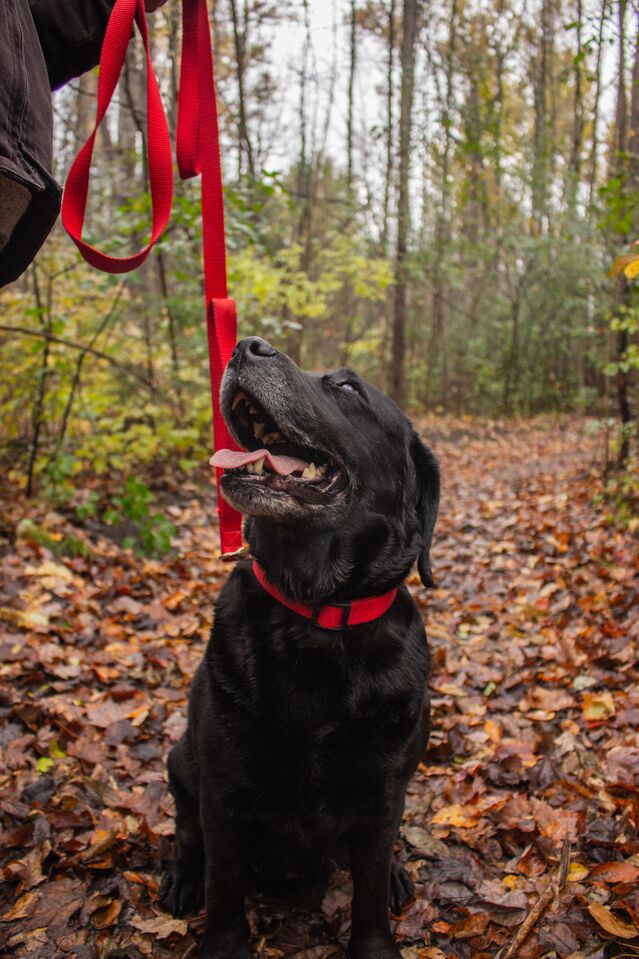Stress
Rethinking How to "Walk the Dog"
Human-dog excursions can be a time of mutual enrichment.
Posted May 24, 2022 Reviewed by Abigail Fagan
Key points
- Dogs and humans have different needs and expectations when it comes to the daily "dog walk."
- Dog-centric excursions allow dogs to make choices, set the pace, engage their senses, and have fun.
- Dog walking supports canine mental health by counteracting the boredom of being inside all day, which can benefit the dog-human relationship.

Bipedalism is unique to humans. Perhaps it makes sense, then, that we label the daily perambulation with our dogs as “walking the dog.” But perhaps what dogs want and need isn’t walking, per se.
We affectionately call dogs our four-legged friends. Like other animals in the four-legged family Canidae, dogs are cursorial: They are adapted, morphologically and physiologically, to running, to chasing, to stalking. Humans are visual creatures and give primacy to visual stimuli. Dogs, of course, “see” the world primarily with their nose. With four legs, and guided by their nose, dogs move through the world differently than we do.
When my local forest trails are freshly covered in snow, the crisscrossing tracks of human and dog are a narrative of overlapping excursions. I see the steady indentations from a human’s boots, about a foot apart and extending in a straight line along the trail, always on the trail. Dog paw prints appear next to the boot-prints at first. Before long, the paw prints veer off left, disappear up the hillside, reappear and cross the trail, come back together for 20 or 30 feet, then move downslope toward a fallen tree. Although dog and human share this time together, they are also busy doing different things. They have different agendas on this “walk.”
Compare the snowy off leash scenario with the classic picture of the dog walk: person and dog, connected by leash, strolling down the sidewalk together at the human’s pace. The “good” dog doesn’t pull, stays on heel, doesn’t stop to linger over smells, carefully attends to the human’s cues. The footprints and pawprints stay side by side. This human-centered form of dog walking may give dogs some daily exercise, and that’s good. But the “walk” can also be a great deal more.
Rather than “take the dog for a walk”—which suggests a human-directed task—a subtle shift in emphasis might expand our expectations and create greater opportunities to make our dogs happy: We are “going for an adventure together with our dog.”
Why walk?
For some human guardians, dog walking is an unpleasant chore necessitated by the inconvenient fact that we haven’t yet figured out how to breed dogs who don’t poop and pee. For others, it is the highlight of the day, a chance to make their dog happy and to spend quality time together enjoying the fresh air. Whether begrudged or embraced, walking the dog is generally considered a component of providing reasonable care.
In a nice article on the benefits of walking, veterinarians Krista Williams and Lynn Buzhardt stress that although letting a dog outside into a fenced backyard for a quick chance to relieve themselves is great, it isn’t an adequate substitute for walking. Walking helps maintains weight and body condition. Obesity, which plagues more than half of all pet dogs in the U.S., reduces quality of life and years of life and can lead to joint problems. Walking helps maintain joint health. As in humans, dogs’ joints must be used to stay mobile and well-functioning. Frequent and predictably scheduled walks—even short ones—can help maintain digestive health and avoid constipation because dogs don’t have to hold their bladder or bowels. Having the chance to regularly empty the bladder also reduces the likelihood of bladder infections.[i]
Daily walking (and hopefully also running, loping, zooming, darting, etc.) also benefits canine mental health by counteracting the boredom of being inside all day. Giving a dog something constructive to do leaves them less time and energy to devote to destructive activities, which can benefit dog-human relationships. Indeed, a common dog training adage is “a tired dog is a good dog.”
Some guardians view the walk as primarily a form of sensory enrichment, providing dogs the opportunity to sniff, to use pee to mark fire hydrants, to taste bits of French fry squished into the cement, to see and hear other people, dogs, and animals. I’ve heard walking referred to as a “sniffari,” emphasizing the sense of olfactory adventure that awaits dogs if we let them follow their noses. The walk might also be a time for social engagement, a chance to meet up with familiar dog and human companions or to make new friends. Given the many possibilities for enrichment offered by dog walking, and given that homed environments can be quite stultifying, I tend to agree with dog advocates who insist that daily walks—at least three of at least 30 minutes each, but preferably more—are essential to dog well-being and something we owe our furry friends.
A Daily Dose of Freedom
One of the recurring themes in my conversations with people about walking their dogs is that they see the daily walk as an opportunity for their dog to have agency. The walk is their dog’s time; their chance to be out of the house, to be “free,” in as much as freedom is possible for pet dogs.
In leash-required areas, this might mean that the human tries to maintain a loose leash by modulating their pace and even their direction of travel according to where the dog wants to go. This runs counter to much dog training advice, which counsels that the human must always be in control and that the dog is fully responsible for maintaining a loose leash—the dog must modulate his pace and direction to match ours and must always pay attention to what we are doing. Pulling and lollygagging are both frowned upon as “bad” leash manners. While it makes sense, from a safety standpoint, for dogs to learn not to pull on the leash because hard pulling can damage a dog’s neck and can cause eye problems, this doesn’t mean that the dog shouldn’t get to choose where to sniff, for how long to linger over a particular aroma, or where to leave pee-mail. Giving dogs agency and choice isn’t going to fill their heads with dreams of canine domination—there is no behavioral link between a dog pulling on the leash and a dog “dominating” his guardian. This is nothing more than a damaging piece of folk mythology.
When off-leash walking is an option, the possibilities for agency blossom. Dogs can choose the pace, the direction. They can have an agenda. They can make choices. When I walk with Bella in my neighborhood, I let her choose which way we’ll go. We head down the driveway and at the end, I’ll stop and ask: “Over the bridge? Or up the hill?” Bella always has an opinion and if I make a wrong choice, she will let me know with a sideways glance. Since the walk is really for her, why not let her be the one to decide where we go?

Walks are not only a time for dogs to experience freedom, but also a time during which we can learn about what’s important to our dog and how the world looks from our dog’s perspective. One way we can get insight is to let the walk unfold as a shared time, letting our dog determine pace, direction, and so forth. We can go further and try taking the “walk” from our dog’s perspective, "becoming dog," as it were. Dog trainer Kristi Benson describes “becoming dog” in a blog on free choice walking. She decides to follow her dog, rather than vice versa. She is willing to sprint, stop with nose to the air, leap over logs, and get on the ground to sniff a pee spot.[ii] Trying to step into our dog’s perceptual world, and seeing what our dog’s “walk” entails, will increase our attunement to our dog’s interests and will help us create adventures that are meaningful. We might also learn new and unexpected things about the places we go.
Not Walking
Sometimes wisdom and good judgment can lead to a conscious decision to not walk a dog. I can think of two circumstances in which not walking is the compassionate choice and there are likely many others as well. One is when physical limitations make walking painful for a dog, whether due to illness, injury, or disability. In these cases, we may be able to find forms of physical exercise that are more comfortable than walking. Bella, for example, can’t walk very far because of an old and unsuccessfully repaired cruciate ligament injury. But she loves to swim and to chase balls in the water. She also loves to ride around the neighborhood in her stroller.

Very reactive dogs for whom it is stressful to be out and about may also benefit from not going on structured walks. Yes, this is sad for the dog and her person, but it may be the most comfortable choice for everyone, and guardians can find lower-stress ways to provide physical exercise and sensory stimulation.
What do we do about refusals to walk? A friend sent me this query a couple of weeks ago: His dog is telling him that she doesn’t want to go on her morning or afternoon walk. She happily goes out to pee and poop next to the apartment, but she resists the walk. It’s not an all-out sit-on-the-haunches refusal but a light indication that she’d just rather not go. She’s been refusing for a couple of days. She isn’t sick or injured, just expressing a preference. Should he force her to go because she needs the exercise? Or should she have the option to be lazy and watch squirrels through the window? If he lets her off the hook today, should he also let her off the hook tomorrow? How many days should he let her go without her exercise?
I suspect the answer is somewhere in middle: We should respect our dog’s preferences, while at the same time ensuring that they are getting enough physical activity to keep their body and mind healthy. Not all dogs enjoy walking, and there are a billion possible reasons that an individual dog might not feel like going for a walk on any given day.
And so...
We might approach dog walking with what Zen practitioners would call “beginner’s mind,” letting go of what we’ve been told by experts is proper walking behavior for us and our dog. Walking can be a chance to collaborate with our dogs on adventures, a special time of the day to be curious about who our dogs are, how they interact with their world, and what makes them happy.
References
[i] Williams and Buzhardt, “The Benefits of Walking Your Dog,” p. 1.
[ii] Benson, “The Essence of a Dog.” http://www.kristibenson.com/blog/2020/5/13/the-essence-of-a-dog.




